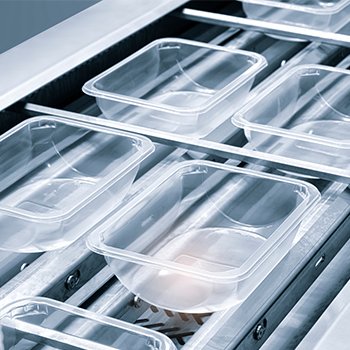ข้อควรรู้เกี่ยวกับประกาศกระทรวงสาธารณสุข ฉบับที่ 435: กำหนดมาตรฐานของภาชนะบรรจุที่ทำจากพลาสติก Important Points of the Notification of the Ministry of Public Health No.435: Specification of Qualities or Standards of Food Packaging Made from Plastic
6894 Views |

By: ธวัช นุสนธรา
Thawat Nusonthara
Department of Science Service
Ministry of Higher Education, Science, Research and Innovation (MHESI)
thawat@dss.go.th.
ภัสสร พงษ์เสวี
Passorn Pongsaeve
Department of Science Service
Ministry of Higher Education, Science, Research and Innovation (MHESI)
passorn@dss.go.th
บรรจุภัณฑ์อาหารมีความสำคัญและเกี่ยวข้องกับชีวิตประจำวันของผู้บริโภคเป็นอย่างมาก เนื่องจากช่วยเพิ่มความสะดวกในการบริโภคและป้องกันการปนเปื้อนของอาหารจากสิ่งแวดล้อม แต่บางครั้งบรรจุภัณฑ์ก็อาจเป็นสาเหตุของการปนเปื้อนไปสู่อาหารได้เช่นกัน ไม่ว่าจะเป็นสาเหตุจากกระบวนการผลิต โดยเฉพาะบรรจุภัณฑ์ประเภทพลาสติกที่มีส่วนประกอบของสารเคมีหลายชนิด เช่น สารตั้งต้นและสารเติมแต่ง ซึ่งสารเคมีเหล่านี้อาจตกค้างและแพร่กระจายไปสู่อาหารจนก่อให้เกิดอันตรายต่อสุขภาพของผู้บริโภคได้ ดังนั้น หลายประเทศจึงออกข้อกำหนดและกฎระเบียบที่เกี่ยวข้องกับบรรจุภัณฑ์อาหาร รวมถึงปรับปรุงกฎระเบียบเป็นระยะเพื่อความปลอดภัยของผู้บริโภค และทันต่อการเปลี่ยนแปลงของเทคโนโลยีการผลิต
มาตรฐานบรรจุภัณฑ์พลาสติกตามประกาศกระทรวงสาธารณสุข (ฉบับที่ 435) พ.ศ. 2565
ข้อกำหนดและรายการทดสอบของประกาศกระทรวงสาธารณสุขฉบับใหม่มีความแตกต่างจากประกาศฉบับเดิมหลายรายการ โดยมีเนื้อหาอ้างอิงมาจากกฎระเบียบของสหภาพยุโรป Commission Regulation (EU) No. 10/2011 และฉบับเพิ่มเติม ซึ่งการตรวจสอบคุณภาพและความปลอดภัยของภาชนะบรรจุอาหารที่ผลิตมาจากพลาสติกมีรายการต่างๆ ดังนี้
1. ปริมาณการแพร่กระจายทั้งหมด
2. ปริมาณการแพร่กระจายของโลหะ 19 รายการ โดยแต่ละรายการมีเกณฑ์กำหนดปริมาณสูงสุด
แสดงในตารางที่ (2) ของประกาศกระทรวงสาธารณสุข
3. สารไพรมารีแอโรแมติกแอมีน (PAAs) สำหรับภาชนะที่มีสีหรือใช้หมึกพิมพ์ต้องทดสอบปริมาณ
การแพร่กระจายของ PAAs โดยกลุ่มสารแต่งสีชนิดแอโซที่มี 22 ชนิดนั้น (Azocolourants) แต่ละชนิดจะต้องตรวจไม่พบที่ขีดจำกัดของการตรวจวัด (LOD) เท่ากับ 0.002 mg/kg ซึ่งสามารถตรวจวิเคราะห์เฉพาะรายการสารที่ใช้ในกระบวนการผลิตและต้องมีข้อมูลหลักฐานในการใช้สารเคมีที่สามารถตรวจสอบได้
4. ปริมาณการแพร่กระจายของสารจำเพาะ (Specific migration limits) โดยรายการทดสอบจะขึ้นอยู่กับชนิดของพลาสติกที่ใช้ผลิตภาชนะบรรจุอาหาร
5. ภาชนะบรรจุที่ทำจากพลาสติกต้องไม่มีจุลินทรีย์ที่ก่อให้เกิดโรค โดยสำนักงานคณะกรรมการอาหารและยาได้กำหนดแนวทางในตรวจวิเคราะห์จุลินทรีย์ที่ก่อให้เกิดโรคบนบรรจุภัณฑ์ไว้จำนวน 4 ชนิด ได้แก่ Salmonella spp., Staphylococcus aureus, Bacillus cereus และ Clostridium perfringens
Food packaging is a very important and integral part of consumer’s daily life as it facilitates the ease of food consumption and prevents environmental contamination of food. Nevertheless, the packaging itself can also become a source of food contamination in the manufacturing process. This is especially true for plastic packaging made from multiple chemical components, such as reactants and additives, which may remain in or migrate to food after production, thus causing harmful effects on consumer’s health. Therefore, to ensure that consumers are safe and all relevant measures can keep pace with constant changes in manufacturing technologies, many countries have imposed regulatory measures on food packaging and ensure that the periodic revisions or amendments thereof are regularly performed.
Standards of Food Packaging Made from Plastic according to the Notification of the Ministry of Public Health (No.435) B.E.2565 (2022)
Specifications and test requirements stipulated in the new notification differ from those in the previous version in many aspects. They are based on the Commission Regulation (EU) No. 10/2011 and its amendments. Safety and quality evaluation of food packaging made from plastic includes the following aspects:
1. Overall migration limits
2. Migration limits of 19 metal types: the overall migration limits for these metal types are shown in Table (2) of the notification of the Ministry of Public Health.
3. Primary aromatic amines (PAAs): colored or printed containers and packaging are required to test for PAAs migration. The prescribed 22 types of azocolourant must not exceed the limit of detection (LOD) or 0.002 mg/kg. Testing can be done on specific substances used in the manufacturing process, but verifiable evidence guaranteeing the use of said chemicals in the production process is required.
4. Specific migration limits: testing will be performed depending on the type of plastic in food containers.
5. Plastic containers must not contain microbial pathogens: the Food and Drug Administration has prescribed a detection guideline for 4 types of pathogenic microorganisms in food packaging: Salmonella spp., Staphylococcus aureus, Bacillus cereus, and Clostridium perfringens.




